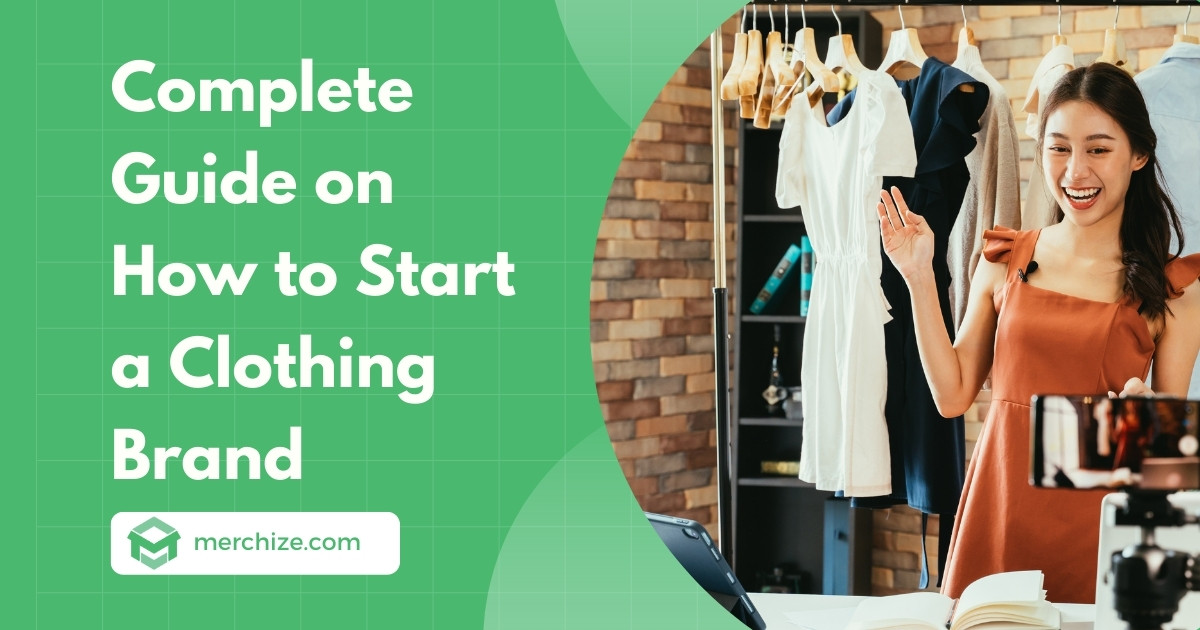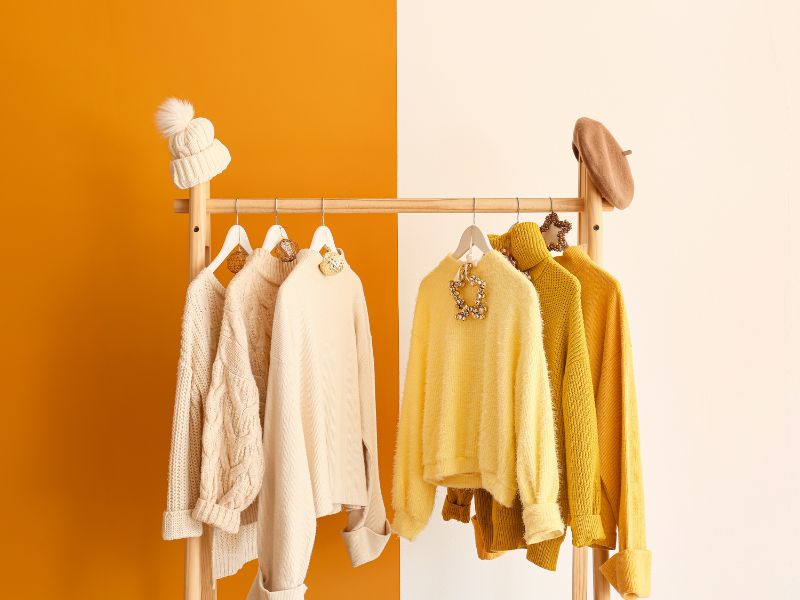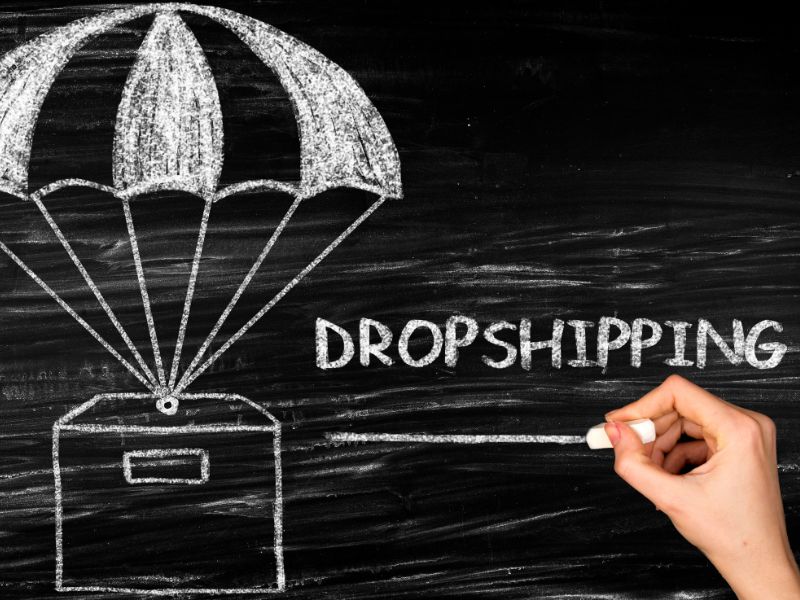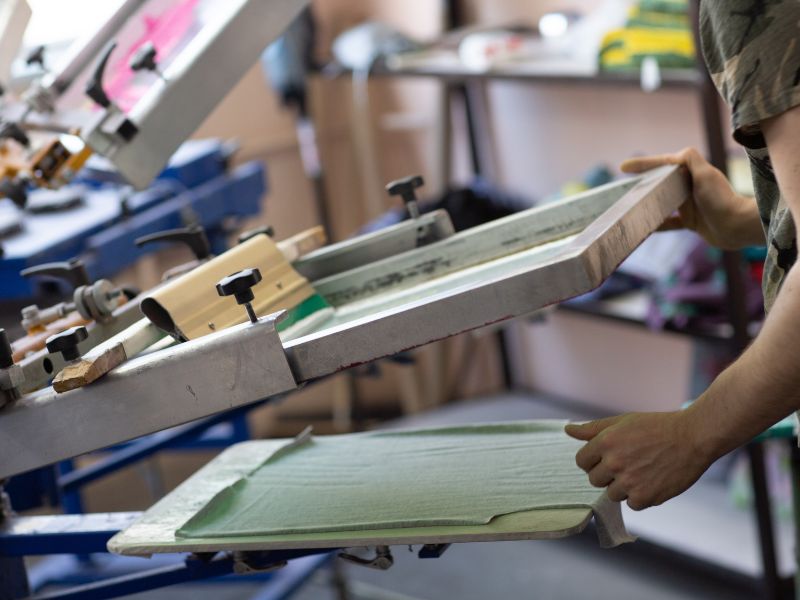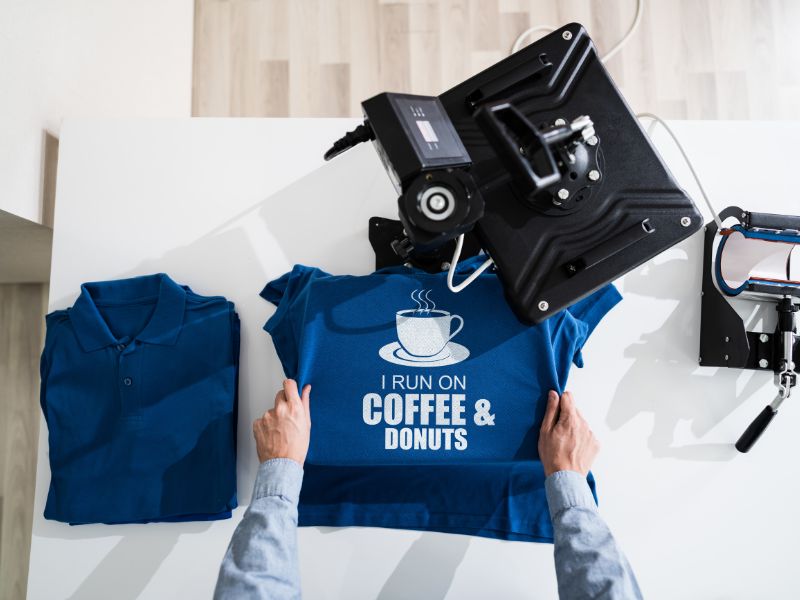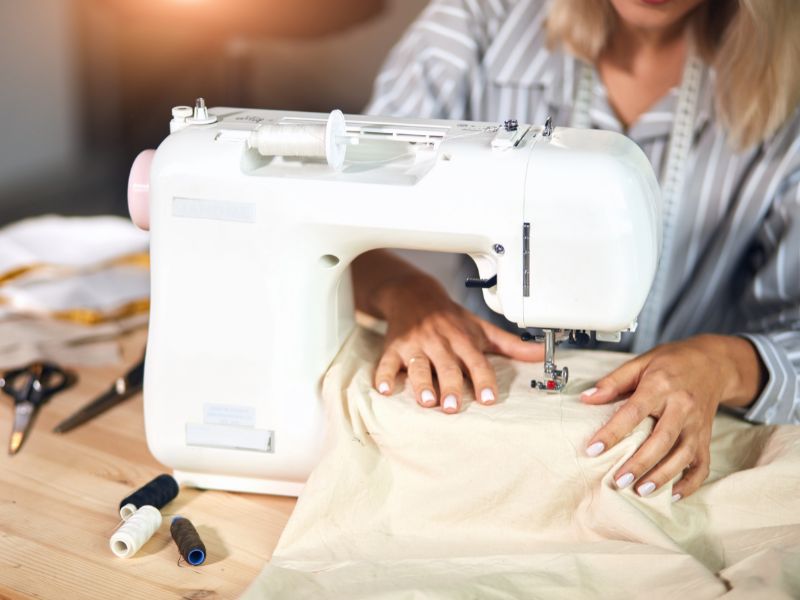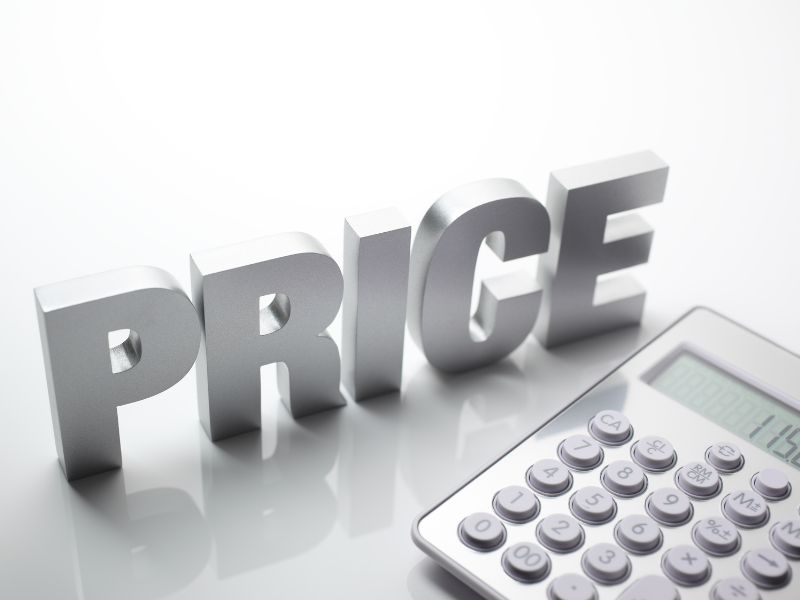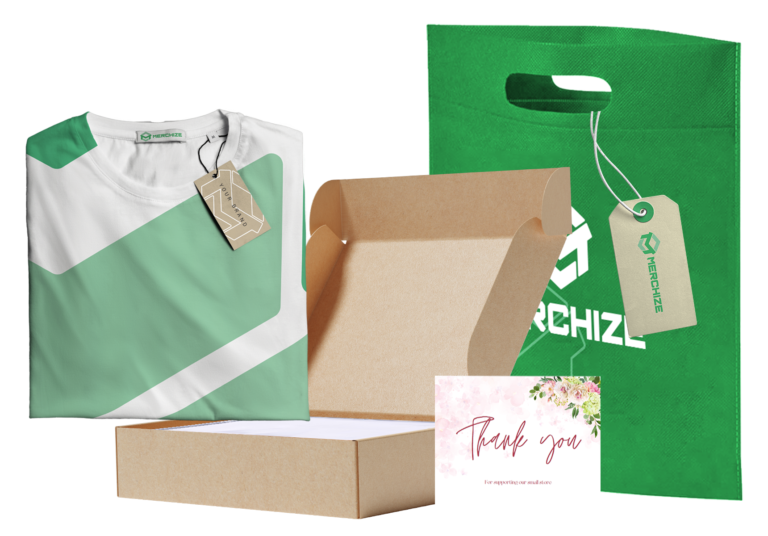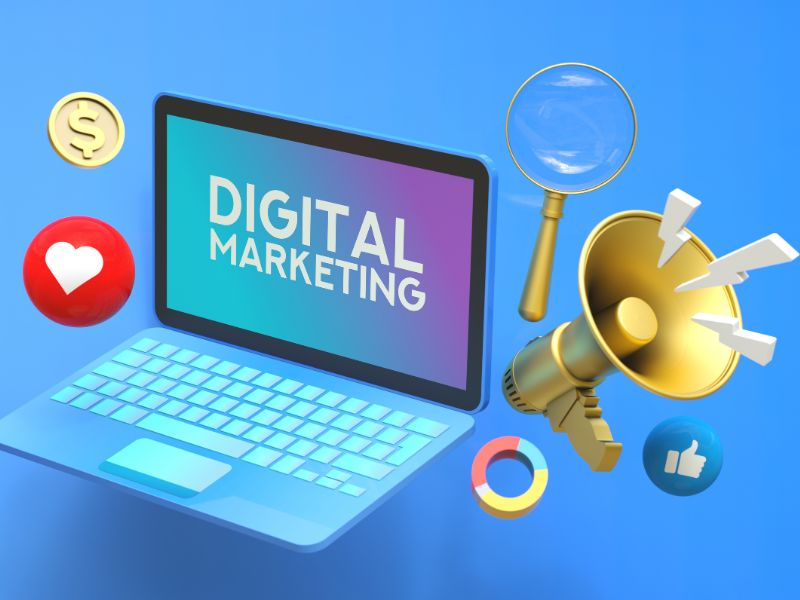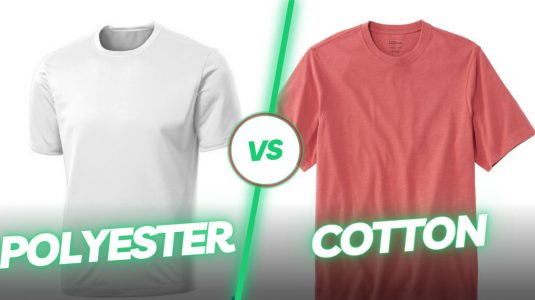Contents
- Why Start a Clothing Brand?
- What Clothing Items to Pick for Your Fashion Brand?
- Which Business Model Is Best for Starting an Online Clothing Store?
- How to start a Clothing brand?
- How to promote your clothing brand
- How to start your clothing brand with Merchize with no upfront cost
Are you dreaming of making something of your own, like an online clothing brand? Are you excited to make stylish and trendy outfits that scream your unique personality? Are you ready to make money from your passion for creativity and fashion? Well, my friend, you’ve come to the right place because today we’re going to walk you through all the steps on how to start an online clothing brand.
Don’t worry, you don’t have to be a fashion expert or have a trust fund to make this dream a reality. All you need is a passion for fashion, a sprinkle of creativity, and a whole lot of determination. So, let’s dive into the wild world of online fashion entrepreneurship.
Why Start a Clothing Brand?
Clothing is not only a mere article that covers our body but also a medium to show personal expression and aesthetic tastes. Beyond all of these, fashion is incredibly lucrative and highly accessible. That’s why many aspiring entrepreneurs choose to venture into this market.
Out of the top 20 direct-to-consumer (DTC) brands listed by 2PM, 13 of them are coming from the fashion and apparel industry, showing how dominant fashion brands are.
Let’s just break down the appeal of the fashion industry and start a clothing brand:
Creating a clothing brand could serve as a way to express your creativity and bring your unique vision to life.
Starting your own online clothing brand can also be a financially rewarding endeavor. With the rise of e-commerce, it’s never been easier to sell products online. Through your online store, your products can reach a global audience and make money even when you’re sleeping.
Last but not least, by starting a clothing brand, you can connect with like-minded people as well as build a community of customers who share the same values and stories.
Running a clothing business is a like creating a bridge to connect your own artistic self, your desire for a better life, and your purpose in life.
What Clothing Items to Pick for Your Fashion Brand?
Choosing the right clothing items to sell is essential to the success of your business. Here are some popular clothing items that you may want to consider featuring in your collection:
T-Shirts
T-shirts are a staple clothing item that can be worn year-round and can be dressed up or down. They are versatile and can be designed in a variety of ways to fit your brand’s aesthetic.
Hoodies and Sweatshirts
Hoodies and sweatshirts are cozy, comfortable, and perfect for colder weather. They can be designed with your brand’s logo or messaging, making them a great option for branding.
Jackets and Coats
Jackets and coats are essential for colder weather and can also be used to add a statement piece to an outfit. They come in a variety of styles, including denim, leather, and bomber jackets, making them a great option for different fashion brands.
Accessories
Accessories, such as hats, scarves, and bags, can be a great addition to your fashion brand. They are a lower-priced option that can still help customers feel connected to your brand.
When choosing clothing items to sell for your fashion brand, it’s important to consider production availability, customer demand, as well as market competition. It’s okay to start with a few options first. Later on, you can extend your product range of clothing items and appeal to a wider audience.
Which Business Model Is Best for Starting an Online Clothing Store?
When embarking on your online clothing store, a key decision you must make is selecting the business model that best aligns with your brand. This choice will have far-reaching implications for your operations, finances, and overall performance.
The good news is that now you are provided with many options that can help you start your fashion business easily and quickly:
Print-on-Demand Model
If you want to kick-start your clothing brand with a small investment, print-on-demand must top as the best option.
With this model, you can create and sell custom-designed clothing without investing in large quantities of inventory upfront. Instead, you print the designs on-demand, which means that your products are only manufactured and shipped when an order is placed.
- High flexibility and low risk: With the print-on-demand model, you can test out different designs and clothing items without worrying about the financial risk of buying inventory that may not sell.
- Unique designs: The print-on-demand model allows you to offer unique designs that are not available in traditional retail stores.
- Ease of operations: You don’t need to worry about fulfillment, shipping, or returns, as your supplier will handle all of those processes.
However, there are some drawbacks to the print-on-demand model. Since you don’t control the production process, you may experience longer shipping times or quality control issues with your supplier. Additionally, the cost per item may be higher than if you were to purchase inventory upfront in bulk.
Dropshipping Business
Dropshipping is an alternative to print on demand if you are really keen on the design part of the process. It’s similar to print on demand in that you don’t need to hold inventory upfront, but instead of printing your designs on clothing items, you work with a supplier who ships the products directly to your customers.
With this business model, instead of making your own designs, you can curate your own collection and promote them to target customers. Your dropshipping partners will take the products from the manufacturer and ship them to your customers’ doors.
Here are some benefits of dropshipping model:
- One significant advantage of dropshipping is the wide range of clothing items you can offer without worrying about storage or inventory costs.
- With dropshipping, you have more control over the production process and can choose from a variety of suppliers, giving you the flexibility to test out different products and find the best fit for your brand.
- The upfront investment required for dropshipping is minimal, making it a more affordable option for those starting a business on a budget.
But also, it comes with a few cons, such as:
- Relying on a supplier to handle fulfillment and shipping can lead to longer shipping times and quality control issues.
- Dropshipping can be a competitive market, so you may need to put in more effort to stand out from other stores.
Both dropshipping and print on demand are excellent option for those who want to start an online clothing store without the need for upfront inventory costs. If you just want to focus on the marketing side of the business then the dropshipping can be a good match.
Private Label or White Label Manufacturing
This option allows you to work directly with the manufacturers and requests them to make your designs in bulk.
Here are some benefits of the private label or white label manufacturing model:
- You can offer a wide range of clothing items without worrying about inventory or storage costs.
- You can negotiate better pricing and have more control over quality control since you work directly with a manufacturer.
- You can create a unique brand identity that sets you apart from competitors and attracts a loyal customer base.
However, there are some drawbacks to this model:
- Upfront costs can be higher than other business models since you’ll need to pay for the design, manufacturing, and inventory costs.
- You’ll be responsible for fulfillment and shipping, so you’ll need to factor those costs into your pricing.
- Most manufacturers will require a minimum quantity. When ordering products in bulk, you are running the risk of keeping unsold stock.
Despite these drawbacks, the private label or white label manufacturing business model can be an excellent option for those who want more control over the design and production process and are willing to invest in upfront costs. If you have a strong brand identity and want to offer unique clothing items not available in traditional retail stores, this model can help you bring your vision to life.
Selling Wholesale
Selling wholesale is another business model to consider when starting an online clothing store. In this model, you purchase clothing items in bulk from a manufacturer or supplier and then sell them at a markup to retailers or individual customers.
Here are some key points to consider when deciding if the wholesale business model is right for your online clothing store:
- One advantage of the wholesale model is that it allows you to purchase clothing items at a lower cost, which can help increase your profit margins. You can also offer competitive pricing to your customers, which can help you stand out in a crowded market.
- With the wholesale model, you have more control over your inventory and can easily restock popular items. This can help you avoid stockouts and ensure that you always have the items that your customers want.
However, one potential downside of the wholesale model is that you may need to purchase a large number of clothing items upfront, which can be a significant financial investment. Additionally, you may need to store and manage your inventory, which can add to your overhead costs.
- If you’re selling to retailers, you may need to negotiate pricing and terms with each individual customer, which can be time-consuming. You’ll also need to factor in shipping and handling costs when selling to individual customers.
- Another potential challenge with the wholesale model is that you may be competing with other retailers who are also selling the same clothing items. To differentiate yourself, you may need to offer unique value propositions, such as excellent customer service or a wide selection of clothing items.
In conclusion, the wholesale business model can be a good option for online clothing stores that want to offer a wide range of clothing items and have more control over their inventory. However, it’s important to carefully consider the upfront costs and potential challenges associated with this model before making a decision.
Making Your Clothing
Are you someone with a passion for designing and creating clothing? Have you ever thought about starting your own online clothing store? If so, then you may want to consider the business model of making your own clothing.
While making your own clothing requires a lot of effort and time, it has some significant advantages, such as:
- You have complete control over the design, materials, and quality of your clothing.
- You can create unique pieces that stand out in the market and cater to a specific audience.
- You can build a strong brand identity based on your signature designs and style.
However, there are some important factors to consider before choosing this business model:
- Do you have the skills and expertise needed to create high-quality clothing that meets industry standards? If not, you may need to invest in training or hire a professional to help you.
- Do you have access to the necessary equipment and materials? This can be costly and require a significant investment upfront.
- Can you keep up with demand as your business grows? Scaling production can be challenging, and you may need to outsource or hire additional help.
Overall, making your own clothing can be a rewarding and profitable business model, but it requires careful planning, dedication, and hard work. If you have a passion for design and are willing to put in the effort, it may be the perfect fit for your online clothing store.
How to start a Clothing brand?
Strategize your clothing business
To make a strong, long-lasting business, you shouldn’t underestimate the preparation process. A good strategy will give you direction and keep you on the right track.
Research market
Market research helps you understand your target audience, identify gaps in the market, and make informed decisions about your product offerings. Here are some tips for conducting market research before starting your clothing brand:
- Define your target audience: Before you can conduct market research, you need to know who your target audience is. This includes demographics like age, gender, location, and interests.
- Analyze your competitors: Research your competitors to understand their strengths, weaknesses, and unique selling points. This can help you identify gaps in the market and differentiate your brand from others.
- Attend trade shows and events: Attending trade shows and events can help you stay up-to-date with industry trends, meet potential suppliers and customers, and network with other industry professionals.
- Analyze online trends and data: Analyzing online trends and data can provide insights into popular styles, colors, and materials. Tools like Google Trends and social media analytics can be helpful in this process.
Remember, market research is an ongoing process, and it’s important to continue to gather insights and adapt your strategies as your brand grows and evolves. By conducting thorough market research, you can set your clothing brand up for success in a competitive industry.
Find your niche
Finding a niche is a crucial step when starting a clothing brand. It helps you identify your target audience, differentiate yourself from competitors, and build a brand identity. Here are some tips on how to find a niche for your clothing brand:
- Identify your passion and expertise: Start by looking at your personal interests and experiences. Do you have a particular style or aesthetic that you love? Have you worked in a specific industry that gives you unique insight? Choosing a niche that aligns with your passions and expertise can help you create a more authentic and compelling brand.
- Research the market: Look at what’s currently popular and what gaps you can fill in the market. Check out online marketplaces, social media trends, and fashion publications to identify emerging styles, movements, or demographics that are underserved.
- Consider your target audience: Who do you want to sell to? Consider the demographics, interests, and values of your ideal customer. Think about what styles, colors, and designs would appeal to them. This will help you tailor your products to your target audience and create more targeted marketing campaigns.
- Look for opportunities to innovate: Once you’ve identified your niche, look for ways to innovate and stand out from the competition. This could involve using sustainable materials, incorporating technology into your designs, or collaborating with other artists or designers.
- Test your ideas: Before committing to a particular niche, test your ideas with potential customers. Use social media, surveys, or focus groups to get feedback on your designs, messaging, and overall brand. This will help you refine your approach and ensure that your brand resonates with your target audience.
Understand your audience
Understanding your audience is essential to the success of any clothing brand. By knowing your target market, you can tailor your brand messaging, products, and marketing strategies to appeal to their needs and preferences. Here are some tips for understanding your audience:
- Study your competitors: If you haven’t built your own audience yet, just look at your competitors’ audience and get to know who they are, what their interests are, and what your brand can do to appeal to these customers.
- Create buyer personas: Buyer personas are fictional characters that represent your ideal customers. By creating buyer personas, you can get a better understanding of your audience’s needs, goals, and preferences. Through these personas, you can keep your focus and create products, messaging, and marketing strategies that appeal to your target audience.
- Engage with your audience: Direct communication with your audience through social media, email marketing, and customer service is incredibly helpful to gain valuable insights. Listen to their feedback and take their opinions into account when making decisions about your brand.
- Use social media analytics: Social media analytics can provide you with valuable insights into your audience’s behavior, interests, and preferences. You can use analytics tools like Facebook Insights, Twitter Analytics, and Instagram Insights to gain insights into your audience’s behavior and preferences.
Choose your business model
Today, it’s super easy to get a business up and running. There are plenty of options that offer incredibly high flexibility. You can run your business remotely, from the comfort of your own home while traveling. You can choose which parts of your business to work on and get rid of boring responsibilities.
We have already listed out the four popular business models for clothing brands, which are print-on-demand, dropshipping, private label manufacturing, or in-house manufacturing.
It’s up to you to select a business model that fits your priority and your strengths.
Determine your budget
To grow a profitable business, you must not ignore the budgeting stage. In fact, with a careful financial plan, you will be able to make the most out of your budget and minimize the risk of losing money. Here are a few bullet points that you should check before making any financial decision for your brand:
- Determine your startup costs: Make a list of all the expenses involved in starting your clothing brand. This includes the cost of materials, manufacturing, branding, marketing, website development, legal fees, and any other expenses that may incur.
- Plan for ongoing expenses: Once your brand is launched, you’ll need to budget for ongoing expenses such as rent, salaries, inventory, website hosting, marketing, and other miscellaneous costs.
- Set a revenue goal: Determine how much revenue you need to generate to cover your expenses and make a profit. Use this information to set a realistic budget for your clothing brand.
- Be flexible: Remember that unexpected expenses can arise, and you may need to adjust your budget accordingly. Be prepared to adapt and make changes as needed.
Select sales channels
Selecting the right sales channels for your clothing brand is like picking the perfect fishing spot – you want to cast your net where the fish are biting. And trust me, in the vast ocean of online retail, there are plenty of fish to catch. But, just like fishing, it’s not about blindly throwing your net into the water and hoping for the best. Other than techniques or tools, the right fishing spot can make a huge difference.
Let’s go through all the major sales channels where you distribute your products:
- E-commerce: Online sales have become an essential part of the retail industry, and e-commerce platforms provide a great opportunity for clothing brands to reach a wider audience. Setting up an online store or selling on established e-commerce platforms like Amazon or eBay can be an effective way to sell clothing.
- Brick-and-Mortar: Physical stores are still a popular sales channel for clothing brands. Having a storefront allows customers to try on clothes before purchasing them, and it can create a more personalized shopping experience. However, it also requires more upfront costs, such as rent and inventory.
- Wholesale: Selling wholesale to other retailers is another option for clothing brands. This allows the brand to reach a larger audience without having to invest in their own storefront or e-commerce platform. However, it also means giving up some control over pricing and branding.
- Pop-up Shops: Pop-up shops are temporary physical stores that can be set up in high-traffic areas like shopping malls or markets. They are a great way to build brand awareness and test new markets without the long-term commitment of a brick-and-mortar store.
How to Choose Sales Channels for Your Clothing Brand:
- Find sales channels that are mostly used by your target audience: Understanding your target audience’s shopping habits and preferences can help you choose the most effective sales channels. For example, if your target audience is primarily younger and tech-savvy, e-commerce may be the best option.
- Consider your budget: Different sales channels require different upfront costs and ongoing expenses. For example, creating an online store can be much more affordable than building a brick-and-mortar store. Consider how much you are willing and able to invest in your sales channels before making a decision.
- Evaluate the competition: Look at how similar clothing brands are selling their products and where they are selling them. This can give you an idea of what sales channels are working and where there may be opportunities for your brand.
- Test and Measure: Experiment with different sales channels and track your results. This can help you determine which sales channels are driving the most revenue and where you should focus your efforts in the future.
Acquire business license
Legal procedures are one of the small things that keep many people from actually acting on their dreams. The endless forms, the confusing regulations, the wait times that make you question the meaning of life… it’s enough to make anyone want to give up and go back to their day job.
But fear not, here’s a simple guideline on how to acquire a business license (without losing your sanity):
- Understand the regulations: Each state and country has its own regulations regarding business licenses, and it’s essential to research and understand these regulations before starting the process. Some of the essential things to consider include the type of license required, the fees, and the renewal requirements.
- Determine the type of license: Depending on the location and nature of your clothing brand, you may need one or more licenses. For instance, you may need a general business license, a seller’s permit, or a tax registration. It’s crucial to determine the specific licenses required for your business.
- Gather the necessary documents: Once you know the licenses required, gather all the necessary documents. This could include your business plan, proof of identity, and tax information. Having everything ready can help speed up the process.
- Apply for the license: Depending on the regulations in your location, you may be able to apply for the license online, or you may have to visit the relevant office in person. Follow the application process carefully and make sure to provide all the necessary information and documentation.
- Pay the fees: There may be fees associated with obtaining your business license, so be prepared to pay them. These fees can vary depending on the location and the type of license required.
- Renew the license: Once you have obtained your license, make sure to renew it before it expires. Most licenses have a renewal period, and failing to renew them can lead to penalties or the revocation of your license.
Make your clothing designs
It’s not easy coming up with creative and innovative designs that will make your brand stand out from the competition. But don’t worry. By applying a systematic and logical method, you can create clothing designs consistently.
Design for your niche
It’s nearly impossible to make designs that everyone loves. To make your way through the cut-throat competition, you must focus on your niches. Make designs that speak to the people within these groups of customers.
Research and follow trends
Keeping up with the latest trends is a must if you decide to work follow the fashion path. It’s a well-known fact that trend cycle is getting shorter and shorter. So if you don’t keep a close eye on the fashion scene, you will miss all of the trends.
But remember this: Don’t jump mindlessly into every trend that you see. To make the most out of the prevailing trends, you must do trend research and analytics to pick up only the looks that matter to your audience and branding.
Create a unique design
You will soon run out of business if you only copy and follow what your competitors are doing. Unique designs are what attract customers and help you get ahead of the competition.
Don’t worry if you have got no idea how to work out unique ideas. Here are a few ways to get your creative juice flowing:
- Observe the latest trends
- Look up your competitors
- Experiment with new color schemes, textures, and fabrics
- Collaborate with other artists
Integrate your brand identity into your designs
A successful clothing brand is not all about unique design. Sometimes, it’s about how well other people can recognize your brand. That’s why many people are willing to throw their money to get anything that comes with a brand logo in it.
If you want to establish a recognizable brand, don’t forget to throw in some brand elements into your product designs, be it your logo, icon, patterns, or your brand colors. On the same note, your design should also align with your branding. If your brand is known for being eco-friendly, you must use sustainable materials for your designs. Or if you are promoting your brand as a premium, luxury brand, don’t ever use cheap and shoddy fabrics and components.
Turn your designs into real products
Congratulations, you’ve designed some killer pieces for your clothing brand! Now comes the fun part – turning those designs into actual, tangible products.
Make clothing products on your own
Source fabrics and material
To make a design that is not only fashionable but also wearable and of high-quality, you must get the right materials.
The search for fabric that can meet all requirements for practicality, look and the price is not easy. You must go down the rabbit holes of fabric research. In order to not get lost, it would be incredibly helpful if you know someone in the biz, who can connect you to wholesales and agents that could provide what you need.
Things could be less complicated if you opt out to use blank products from manufacturers like Gildan and Bella Canvas. These companies provide a wide range of items, from classic t-shirts, tank tops, hoodies, sweaters, sweatshirts, etc. This is ideal for those who want to start a street-style, casual clothing line.
Set up clothing production and manufacturing
After you got the necessary materials, now it’s time to set up the production to turn these raw materials into actual, wearable items.
This part of the process can get very complicated and technical. To keep it simple and understandable for starters, we will give you some bullet points on how to set up the production for your clothing line:
- Estimate the product needs: How many products you want to make (which should be aligned with how much you can sell) will determine the production capacity. Based on these estimations, you will adjust the facility, select equipment, and hire staff accordingly.
- Establish a production process: In order to keep your business running smoothly and each product is made properly, you must plan out a detailed, step-by-step production process. Standard manufacturing should include cutting, printing, sewing, finishing, quality control as well as packaging and shipping.
- Set up facility and machinery: Find a space where you can make your own clothing. It could be a warehouse or your garage at home. Also, make sure the machine works properly and delivers exactly what you want.
- Hire and train employees: It’s possible to run the whole business alone. However, when more orders come, it’s likely that you must hire staff to keep up with the increasing demand.
Work with clothing manufacturers
Compared to working on your own, partnering with your clothing manufacturers will save you more time and effort in producing and focus more on designing and advertising.
When it comes to choosing your manufacturer, you should pay extra attention to the product quality. It’s highly recommended to visit the factory if possible. Or at least, make sure you order samples and test the quality of their products before putting designs into production.
Here are a few checkpoints for clothing products:
- Durability: If you want to keep customers coming back for more, your material must endure the test of time. Durability testing is a crucial step to ensure that your cloth will last.
You can test clothing’s durability by wearing and washing them. To see how a product holds up after use, it might take a while to test and try, which is why many people will skip this step and decide just by looking at the materials only.
- Fit: Sizes do matter. Fit is among the main key points that customers pay close attention to. Don’t forget to be size inclusive and find manufacturers that can provide a wide range of sizes.
- Materials: Features like moisture-wicking, breathability, and stretch are a few factors that customers usually look for. Materials like cotton or cotton blends will be ideal most of the time. However, in some cases, it makes more sense to go with polyester or nylon materials, for example, if you want to make all-over print designs or if you prefer durable and wear-resistant materials. Make sure you understand customers’ needs for each product.
Set prices for your products
Handling pricing is very challenging, or not to say, one of the most difficult. Pricing decides your product margin, your brand positioning, and your competitiveness. Let’s see what are ways to help you set justifiable and competitive prices for your products:
- Estimate the cost: It’s time to do your math. Calculate all the expenses to run your business, including costs for materials, labor, marketing, and other overhead expenses like rent, utilities, etc. By taking into account all of these expenses, you will know where is the line for your business to make a profit.
- Check your competitors: When it comes to pricing, you should never leave your competitors out of the picture. Instead, you should put your competitors in the spotlight. Through your competitors, you will see how much customers are willing to pay and how you should optimize your cost for more competitive pricing.
- Consider your target audience: Spending budget can vary greatly between different groups of customers. It is important to take into account factors such as age, income, lifestyle, and spending habits of your target audience to adjust your price to appeal to them.
- Determine our value proposition: While it’s important to keep your pricing competitive, in some cases, it’s smart to know your worth and how well your products can fare against other competitors, thereby, putting a price that can really reflect your propositions. If your products got what customers are looking for, be it unique designs, or outstanding materials, customers are willing to pay more.
Build your branding identity
Without strong branding, your clothing line might not be able to last a day against the harsh competition in the fashion industry.
Choose a business name
Business name is the foundation for building your brand identity. Branding is all about making your business known, recognized, and remembered.
A good name for a business should be short, easy to remember, unique, and relevant to your audience.
Create logo
Logo is the visual representation of your business. It helps you convey your brand and your messages in just a glance. Whether you want to build elegant branding with a premium position, or a sporty, casual brand, your logo, including color scheme, font, and design styles, must adhere to that brand image.
For this matter, you should work with a professional designer who can translate your brand identity into a visually impactful logo.
Set up your branding guidelines
It is advisable to have a full brand guideline to create a coherent and consistent brand identity across your brand existence. A well-defined brand guideline will help you to develop materials like logos, websites, social media, packaging, and even product designs.
Here is a brief of what a brand guideline should include:
- Color palette: The primary and secondary colors should be defined clearly as well as how they should be applied across your brand materials.
- Logo: Apart from the main, full logo, there should also be other versions with different arrangements or even color schemes to use in different settings.
- Typography: Brand guidelines must detail what are the main typography, font styles, sizes, and spacing and how to apply them.
- Imagery: Other factors like photos, illustrations, and artwork are also a part of the brand guidelines.
Photograph your clothing brand
Good photographs are clearly the shortcut to increasing your sales and enhancing your branding, especially for an online clothing brand.
Online customers can’t physically touch or try on the product, which is why many resist making purchases. But with high-quality images, customers can virtually see your products and how your products look in real life. It will help to encourage customers to make purchases and increase your conversion rate significantly.
However, for print-on-demand clothing lines, it might be a hassle to take pictures of the real products as you don’t hold the stock and do not have the sample always at your disposal. That’s when online mockups can come in handy. You can create attractive, high-quality images using stock images online. This way you can make product images easily and in bulk.
Open your online store/retail store
Your storefront is the facade of your business. With the growth of e-commerce and the prevalent tendency to shop online, an online store has become a constant for every business. It is not only the place where customers can buy your products without visiting a physical store but also a digital catalog for buyers to look at and for you to present your products to others in the online world.
Here are two major options to consider when you want to open an online store:
- Ecommerce website builders (Shopify, Woocomerce, Wix, Squarespace, BigCommerce): You will have your own website with your own domain and you can control how to run your business online. But you will have to build your website from scratch as well as attract visitors to your website.
- Ecommerce marketplaces (Amazon, eBay, Etsy): For this option, you will sell via Amazon, eBay, or Etsy’s website. All these marketplaces already have a huge customer base. By showing up on these marketplaces, you can take advantage of their existing audience.
How to promote your clothing brand
You got amazing products and a system to support your brand to thrive in the market? It’s time to bring your products to a wider audience.
Find your platform to promote brand
Depending on your target audience, you can identify the places where the
Build your social media presence
Social media platforms like Instagram, Facebook, and Twitter are powerful tools to promote your clothing brand. You can create engaging content, showcase your products, and interact with your audience to build a strong brand image. Use relevant hashtags and collaborate with influencers in your niche to reach a wider audience.
Work with influencers
Collaborating with other brands, influencers, or designers in your niche can be an effective way to promote your clothing brand. You can collaborate on a new collection, host an event, or run a joint social media campaign to reach a wider audience and build brand awareness.
Try paid advertising
Paid advertising is incredibly helpful to gain momentum for your store. Paid advertising on platforms like Google Ads, Facebook Ads, and Instagram Ads can help you reach a larger audience and generate more sales. These advertising services give you tools to create a focused, efficient marketing campaign targeting specific demographics, interests, and behaviors.
Offer attractive discounts and promotions
Strategically planned discounts and promotions can give a boost to your sales and your branding in general.
There are many types of promotions and discounts you can offer, such as percentage off, buy-one-get-one, free shipping, or gift with purchase. Choose a promotion that aligns with your goals and resonates with your target audience.
Use social media platforms to promote your discounts and promotions. Use eye-catching images and creative captions to grab your followers’ attention. Consider partnering with influencers to reach a wider audience.
Don’t forget to Send email campaigns to your existing customer base to announce your promotion.
How to start your clothing brand with Merchize with no upfront cost
If you want to start your clothing line with no upfront cost and no minimum quantity, Merchize will help you to realize your dream.
Here’s why you should choose Merchize as your print-on-demand provider on your entrepreneur journey:
- Merchize has seamless integration with multiple ecommerce platforms, from Etsy to Amazon, eBay, allowing you to expand your business and multiply profit.
- Merchize products a wide selection of products from different fulfillment centers across the world, from Vietnam, China to the US, EU, and Australia, allowing you to make your cross-border business grow faster and more efficiently.
- Merchize provides various in-demand services like Branding, FBA Services, or storefronts that cater specifically to your business needs, apart from print on demand service.
- Merchize gives you highly competitive pricing that helps you to improve your profit margin.
How to start your clothing brand with Merchize
- Open your Merchize account
- Connect your Merchize account to your store
- Create your designs and sell products
By following our guidelines on how to start your clothing brand, you can kick-start your business in no time. During the process, you will be able to learn more about how to make your clothing brand flourish and how to operate a running business.
